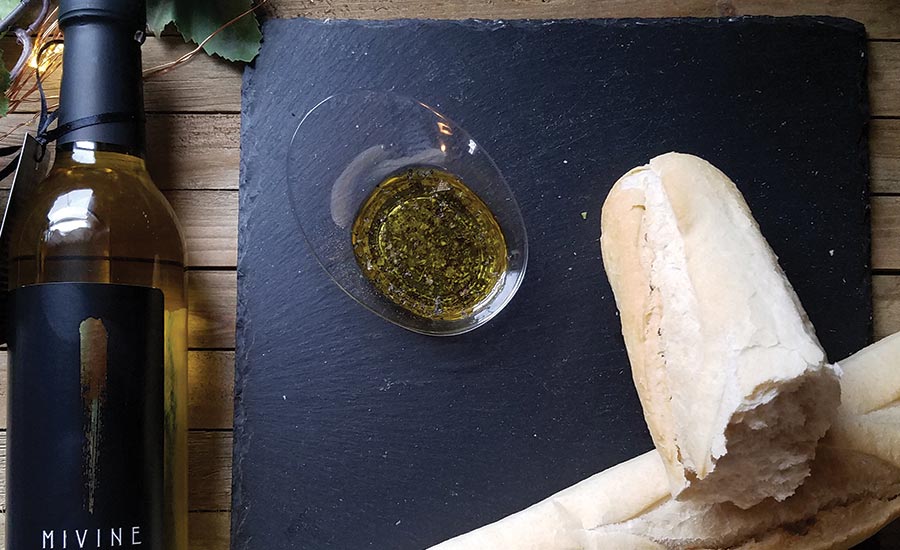Food Oils Are Healthier and More Diverse Than Ever
Oil Boom

PHOTO COURTESY OF: Bunge Ltd. Food Co. (www.bunge.com)

Healthy oils and fats are culinary stars in their own right.
PHOTO: Manitoba Canola Growers (www.canolagrowers.com)

New-to-the-market oils, such as sacha inchi, provide a number of benefits, including unique lubricity, mouthfeel, health benefits, and good flavor.
PHOTO COURTESY OF: getty images

Specialty oils play a crucial part in the exploding dairy analog industry, allowing accurate mimicry of the flavor, mouthfeel, and performance of dairy.
PHOTO COURTESY OF: AAK AB (www.aak.com)

Consumers want healthier choices, but still demand flavor. Oils such as high-oleic canola, rich in omega 9 oils, helps meet those demands.
PHOTO COURTESY OF: Corteva Agriscience Co. (www.omega-9oils.com)

Unrefined oils preserve not only the flavor and aroma of their source but also the beneficial antioxidants such as polyphenolic compounds and vitamin E.
PHOTO COURTESY OF: Royal Grapeseed Inc./MiVine (www.royalgrapeseed.com)






The global food fats and oils market is expected to surpass $270 billion dollars by 2023, with a compound annual growth rate (CAGR) of 5.2% during the forecast period (2018-2023). This statistic, from a recent report by Mordor Intelligence, Inc., demonstrates that, while such a big industry wheel takes a long time to turn, it covers a lot of ground. Recent changes, geared to address health and sustainability, have thus had a huge effect on not only the industry itself but every business it touches.
According to proponents of the Mediterranean diet, avocados, olive and canola oils, nuts, and fish rich in omega-3s are your friends and should be part of a healthy, well-balanced diet. In fact, a meta-analysis of more than 1.5 million healthy adults demonstrated that following a Mediterranean diet was associated with a reduced risk of cardiovascular mortality as well as overall mortality.
Olive oil, the staple of the Mediterranean Diet, is enjoying another wave of close attention. As olives commonly grow in the same regions where wine grapes are cultivated, it’s no surprise that they also have “terroir.”
With the similarly healthy avocado and grapeseed oils providing strong competition lately, it’s reasonable to expect olive oil marketers will make greater efforts to take advantage of the terroir factor in the near future.
It would be no surprise to begin seeing products marketed as having been specifically “made with Tunisian olive oil,” for example.
Olive oil continues to be a mainstay in a number of food products. Although the industry has been beset by counterfeiting and purity issues, reliable ingredient suppliers can ensure pure, high-performing and flavorful sources of olive oil.
OIL BOOM
There currently is a plethora of different oils on the market. Besides the classic oils used in food manufacturing from soybeans, canola, corn, palm, sunflower seeds, safflower seeds, and peanuts, oils commonly being used in food manufacturing now come from avocados, grapeseed, coconut, red palm, rice bran, and nuts.
But other oil sources have begun entering into the prepared foods mix as different food trends drive manufacturers to opt for everything from gluten-free to non-GMO to eco-friendly/sustainable sources. A number of seed oils have benefited from these trends.
While cottonseed oil is making a comeback, other seed oils, such as those from chia, hemp, and flax, are making good inroads. Also moving into the batch production stream are some unusual oils, such as argan oil, algae oil, and oil from sacha inchi (Plukenetia volubilis).
Sacha inchi, also called “starseed,” is a high omega oil with an excellent balance of omega3s, 6s, and 9s. It also is highly stable due to its unmatched content of antioxidant vitamin E (2,000ppm as tocopherols in addition to tocotrienols). The South American nut, also called the Incan peanut, is similar to peanut oil in flavor and texture. Although the unrefined oil has a lower smoke point than many cooking oils (around 385˚F), it does perform well in fast-cooking operations, such as sautéing.
High-oleic oils, such as high-omega 9 fatty acid canola oil, also have been trending high due to their superb performance and health profile. Crafted via traditional plant breeding, omega-9 canola oil boasts among the lowest levels of saturated fats and highest monounsaturated and polyunsaturated fats. The oil can help manufacturers create products that help consumers meet dietary guidelines recommendations, without negatively impacting taste or functionality.
NUT AND SEED OILS
Nuts and seeds come in all different shapes, sizes, colors, and textures and serve as highly versatile ingredients for food designers. Other prepared products from nuts include flavoring extracts, flours, milks, pastes, oils, and nut butters. With nut oils, the cold-pressing process preserves the taste, aroma, and nutraceutical content of the product.
Nut sources used for food oil production have been typically limited to peanuts, almonds, and walnuts. Seed sources include sesame seeds and sunflower seeds. A number of companies are now making snack products such as chips and crackers with almond oil, and sesame oil is a favorite staple oil for certain Middle Eastern and Asian cuisines.
Who says good things don’t come in small packages? Chia seeds are brown, black or white seeds almost as small as poppy seeds. They come from a plant in the mint family. According to Mordor Intelligence, the chia seed market is one of the fastest growing commodity markets globally and is projected to reach $2.1 billion by 2022, with a compound annual growth rate (CAGR) of nearly 41% during the forecast period of 2017-2022.
Extra virgin, cold-pressed chia seed oil has been getting its share of buzz recently. The tiny seeds are primarily grown in Chile as well as other Central and South American countries. Even unrefined, chia oil has a high smoke point — above 400˚F — and a neutral flavor that makes it suitable for dressings, sauces, smoothies, and soups, and for healthy cooking and light sautéing.
The oil in chia seeds contains higher amounts of essential fatty acids than other oils, even flax seed (linseed) oil, being composed of about 75% omega-3 fatty acids as alpha-linolenic acid. Other oils that are trendy to use are sesame oil and nutty, flavorful pumpkin seed oil (although it has a lower smoke point and is more suitable for dressings than cooking).
Grapeseed oil has been trending up recently, appearing in various snacks and chips. Research group Wise Guy Reports Inc. shows an expected 3.7% worldwide grapeseed oil sales increase between now and 2024, with global sales climbing from about $360 million to $450 million per year.
Grapeseed oil works well for stir-frying, sautéing, and baking. The oil has a clean, neutral flavor, so it also works well in cold formulations. It has been appearing in products ranging from salad dressings to spreads and even on-the-go meals and vegan mayonnaise.
For cold formulations, unrefined expeller-pressed oils give the most flavor and health benefits (as opposed to solvent-extracted, bleached and deodorized oils). Grapeseed oil is no exception. Premium versions use Concord grapeseeds that come from grapes pressed for juice, not following fermentation as with grapeseed oil from wine grapes. The oil delivers a light, fruity flavor and aroma.
Avocado oil, too, is similar to grapeseed and olive oils in that it is growing in popularity. Most applications using avocado oil have been snack foods such as potato chips and crackers. It has a rich flavor, and the highest smoke point of any plant-derived oil at 520˚F.
Sunflower oil has several advantages when used in processed foods. It is a high-oleic oil (between 82-88% monounsaturated fatty acids), which helps extend its shelf life. In addition, all sunflower oils are non-GMO and have a neutral taste profile. “Sunflower’s ‘healthy halo’ makes it ideal when formulating better-for-you snack products,” says John Sandbakken, executive director for the National Sunflower Association.
“We use both expeller- pressed sunflower and safflower oils in our Late July line’s Organic Chia & Quinoa restaurant-style tortilla chips,” says George Vindiola, vice president of R&D for Campbell Food Co.’s snacks division. “It fits our brand’s commitment to sourcing the highest quality organic and non-GMO ingredients.”
High-oleic safflower oil is also non-GMO. It consists of about 75% monounsaturated fat, 13% polyunsaturated fat, and 7-8% saturated fat. This oil is used by Snack It Forward, LLC, to make its legume-based puffed cheese curls, World Peas Brand Peatos. The oil has a mild-to-neutral flavor that works well with the pulse flour blend in the product, and also contributes to a longer shelf life.
TROPICAL OPTIONS
Natural rice bran oil is another oil that has a high smoke point, so it, too, works well in frying applications. It boasts a favorable low-linolenic- to-high-oleic ratio. Rice bran oil also can help replace trans fats and is rich in antioxidants. It’s also a source of the powerful tocotrienol form of vitamin E. While rice bran has 2,500 ppm antioxidants, olive oil only has about 50 ppm.
Coconut oil has increased greatly in popularity, as a result of both the boom in popularity for all things coconut as well as its use in global cuisine.
Coconut oil is commonly used in baked goods, pastries, and sauces. Its pleasant, rich, nutty flavor also adds a touch of sweetness.
It also helps that research has indicated that, unlike saturated fats from animal sources, the saturates in unrefined tropical plant oils do not seem to pose significant health risks in healthy persons. In fact, some studies have shown strong positive health benefits from adding tropical plant oils to one’s diet.
Coconut oil is composed of mostly saturated fat, with the predominant fatty acid being the 12-carbon medium-chain lauric acid. Coconut, palm kernel, and palm oil have saturated fat contents of 92%, 82%, and 50%, respectively. Coconut oil and some of the other tropical oils can replace fats that are high in trans fatty acids and still contribute tenderness and flakiness to baked products.
FRIEND OR PHO
Natural palm oil is another versatile semi-solid alternative for partially hydrogenated oils (PHOs) and finds utility in the baking and snack industries. It can be fractionated via a heating-cooling-crystallization process to produce fats with varying solid fat content and melting points.
Used as a replacement for products that need a high solid fat content, palm oil demonstrates good oxidative stability and generally is less expensive than most other oils. Unrefined, it is naturally orange-red in color due to a high concentration of carotenoids, primarily beta-carotene and lycopene. It also is rich in phytosterols and the more powerful form of vitamin E, tocotrienol.
Palm oil can be blended with other oils such as canola to produce products with lowered saturated fat content but full functionality. Palm oil should not be confused with palm kernel oil, which is derived from the kernel of the same fruit. While palm oil is 50% saturated, palm kernel oil is more than 85% saturated. A higher level of saturated fat gives the latter a higher melting point.
Palmitic acid, a 16-carbon saturated fatty acid present at approximately 44% in palm oil, forms very small, stable crystals that can trap air. This is an essential function for creamy fillings, fluffy cakes, and flaky pastries, giving them a smooth texture. It’s also naturally high in antioxidants, a factor that translates to longer shelf life.
Palm oil compares well to soy oil in performance and cost, is label-friendly, and can readily replace partially hydrogenated soybean oil. While the controversy surrounding palm oil’s sustainability has been met with strong efforts by the Malaysian government to preserve and protect the flora and fauna affected by the palm oil industry, African and South American sources have entered the market to compete.
SOY STILL STRONG
The United Soybean Board has stated that after 25 years of “cropportunities,” revenues for US farmers have nearly quadrupled, from $11 billion to $41 billion. Late last year, the FDA authorized the use of two qualified health claims stating that oils high in oleic acid (between 70-75%), such as high-oleic soybean oil, could help reduce the risk of coronary heart disease.
High-oleic soybean oil, approved for global use in December 2017, offers food companies increased functionality, such as extended fry life, greater stability, and a neutral flavor profile. These qualities make it ideal for frying, sautéing, baked goods, and snack foods. Oleic acid is an 18-carbon monounsaturated fatty acid and is the most common fatty acid in nature. For comparison, olive oil contains between 55 and 83% oleic acid.
A new line of soy-based margarines and shortenings will soon hit the market. The margarines are formulated with interesterified high-oleic soybean oil or conventional soybean oil, or combinations of both. They have been shown to be on par with butter and outperform palm oil and PHO in puff pastry applications where bake height, structure, and honeycomb texture were compared.
These new margarines can maintain their plasticity under both cool and warm temperature conditions. Moreover, high-oleic shortenings developed through interesterification (see sidebar, page 92) also perform as well or better than PHO, and outperform palm-based shortenings (and even lard) in pie dough evaluations, including firmness, flakiness, height, and temperature workability.
Doughs made with interesterified high-oleic oils are versatile, suitable for hand-rolling conditions or a pie press, and produce crusts with commonly desired characteristics, such as even browning, flaky texture, an ideal finished product height, and minimal shrink.
A recent study that evaluated performance of high-oleic soybean compared to other shortenings in cookies showed that, while all the shortenings investigated produced a product similar to the PHO standard in terms of cookie spread, height, and weight, cookies prepared with either high-oleic soybean or conventional soybean shortenings had a more tender mouthfeel.
With so many food oil options available to food manufacturers, it’s no surprise the future looks shiny for cooking oil. In fact, last summer, Transparency Market Research, Inc. reported that, while “the global cooking oils and fats market is highly fragmented due to presence of numerous key players,” sales were expected to Expand with a CAGR of 0.7%.”
The report cited that this healthy increase is attributable to the “growing demand for high quality edible oils and fats.” Consumers are demanding better performing, healthier oils and fats and the industry is definitely demonstrating that it can meet the challenge.
ALGAL INNOVATION
After some seemingly false starts, algae oil is available as an oil, a non-aerosol cooking spray, or a powder. The first consumer brand of culinary algae oil was launched a few years ago. Algae oil has the highest level of monounsaturated fat — the “good fat” — which helps make it more heat-stable than any other cooking oil. Another cooking advantage is its high smoke point of 485˚F (252˚C).
Just one tablespoon provides 13g of monounsaturated fat, which is the same amount found in one whole avocado, and about 25% more “good fat” than olive oil or avocado oil. Algae oil also has the lowest saturated fat level of any cooking oil, with 75% less saturated fat than either olive oil or avocado oil. Its light, neutral taste allows the natural flavor of food to shine through, and its exceptionally high smoke point makes it great for healthy high-heat cooking — versatile for frying, baking, broiling, or sautéing.
Algae-based powders and oils can work well in a variety of foods, from cookies and crackers to French fries. This functional food ingredient can replace eggs, dairy fats, and other oils as well as improve the texture of gluten-free products while boosting a product’s fiber and protein levels.
FUN FACT
The market for palm oil is expected to grow at a 6% CAGR. Palm oil accounts for roughly 30% of the global vegetable oil market and is a bigger player in Asian markets, whereas soybean oil still dominates the US market.
Looking for a reprint of this article?
From high-res PDFs to custom plaques, order your copy today!













